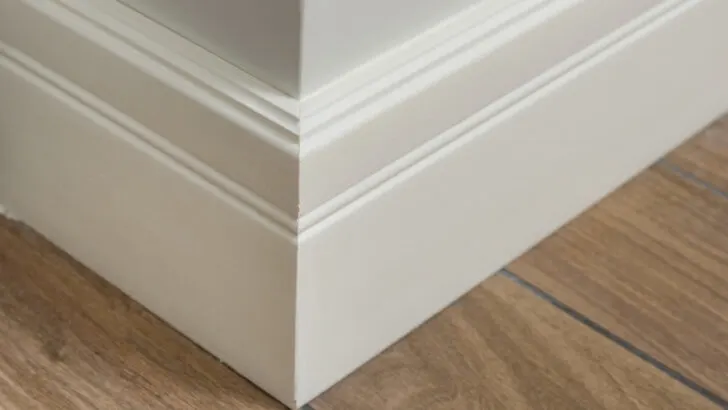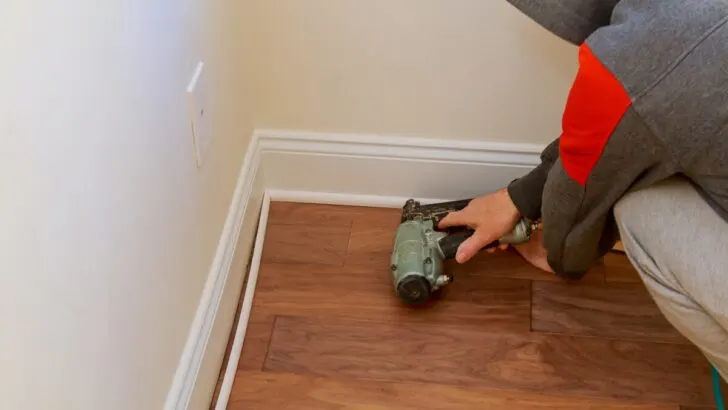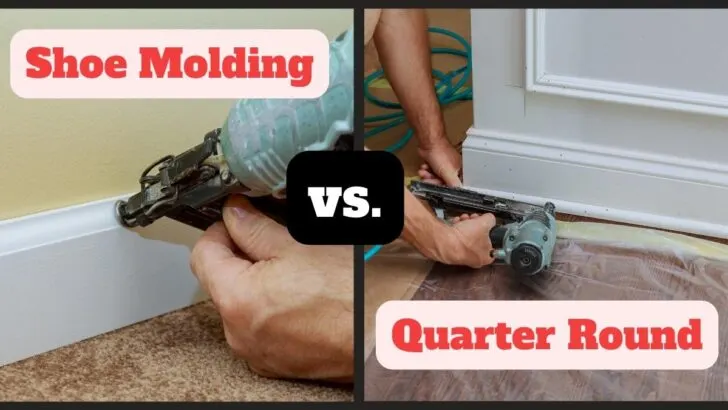Baseboards are a key component of any home renovation but sometimes, they are not enough to hide the joint between the wall and floor.
A little bit of trim, such as shoe molding or quarter round, can elevate the aesthetic and design of the room by covering any gap between the baseboard and the floor.
Although a baseboard doesn’t always need this extra molding, as its stiffness and large size don’t let it conform to uneven floors.
Adding shoe molding or a quarter round that matches the baseboard and floor lend elegance and sophistication to the room by building smooth transitions between walls, floors, and counters.
However, how do you know the difference between the two?
Shoe molding and quarter round are often used interchangeably, as they both have curved edges and accomplish the same purpose of concealing any seams or mistakes in the ground and baseboard. However, shoe molding is generally smaller and thinner than quarter round.
Their distinct designs are suitable for unique purposes, and knowing this subtle difference is the key to choosing the best materials for your home.
What Is Quarter Round?
As its name suggests, quarter round is simply shaped like a quarter of a circle – a perfectly curved edge. This sleek curve looks professional and as a quarter round comes in many different sizes, its versatility is also unmatched.
Besides a design difference, a quarter round is also slightly larger than a shoe molding.
This is an important consideration when deciding between the two because the larger the baseboards, the bigger you need your trim to be.

What Is Shoe Molding?
This thin strip of molding also complements a baseboard with a curved or round shape. However, its curve is not symmetrical like a perfect circle.
On the contrary, the radius of a shoe molding is cut short so it can descend like a flat edge, and this produces a thinner trim which is perfect for smaller rooms.
Since it is at shoe level, shoe molding is also referred to as the base shoe. Its thin profile looks graceful and stylish and makes it flexible as well.
This narrow shape can be easily bent into different shapes. Shoe molding takes considerably less space than quarter mold.
Choosing Between Quarter Round and Shoe Molding
Now that you know the design differences between the two, there are many factors that you need to keep in mind before you invest in either of them.
Design
The best thing about a home renovation is that you get to make the home of your dreams. Therefore, the most important thing is what you want. Since you are the one who has to look at the trim every day, how a quarter round and shoe molding look to you is the priority.
Some people believe that the baseboard should be enough and that any additional trim makes the room appear smaller. However, others prefer the finished look and lack of gaps offered by molding.
While a large chunk of the population loves the elegance of narrow shoe molding, others find it insufficient. They want something larger, like a quarter round.
Even after picking between the two, there are different designs and materials for molding. Shoe molding can also be uplifted with decorative patterns which appeal to many.
Try out both of them and see what you like better.
Size of the Room
As discussed above, a quarter mold is larger than shoe molding. While the former’s general dimensions are 0.75 x 0.75 inches, the latter is available at 0.5 x 0.75 inches.
If you have a room with high walls, ample space, and large baseboards, the bigger quarter mold is more compatible. It will offer a more substantial and satisfying look.
If you install a quarter round in a small room cramped with furniture, this bigger trim is likely to overwhelm the aesthetic. This is why the trim shoe molding is perfect for narrow hallways, and tight rooms.
Therefore, the size of the trim should be proportional to the size of the room.
Gap Between Floor and Baseboard
As you can guess, larger gaps require a larger trim to fill them up. If there is substantial space between your floor and baseboard, shoe molding will not be enough to clean this discrepancy.
If you are unsure of how big the gap is, sample both a quarter round and a shoe molding and see what fits.
If the gap is too narrow, you might not need a trim in the first place. If you plan on having a carpet in the room, that can hide any gap. Shoe molding is never used over carpet because it makes changing the carpet in the future very inconvenient.
This gap is also determined by whether your home renovation included changing the floors.
If you installed new flooring over the existing one to save some cash, that reduces the size of the baseboard. In that case, going with a bigger trim like a quarter round may be too much.
However, if you uninstalled the flooring and then replaced it with a new one, your baseboard height isn’t affected at all and you can choose a trim based on the other factors discussed above.

Picking and Installing A Trim
Once you have picked which of the two products you will be installing in your room, it is time to pick the design and material. Both shoe molding and quarter round commonly arrive in three materials:
- Wood: This natural option from oak, ash, walnut, or other trees is elegant, aesthetic, and immune to cracks, but it comes at a high price. Like trees, this is not smooth but that lends a rustic appeal to the baseboard.
- Medium Density Fiberboard (MDF): Its flexibility makes it the most versatile material out there, being used in everything, from baseboards to flooring to molding. It can easily mold to any uneven gaps under your baseboard. This material made from a combination of sawdust and resin is cost-effective, easy to paint, and solid.
- Polystyrene: The most affordable of all, this plastic option is lightweight and easy to install. Although it is not as durable and can easily dent if bumped, its selling point (besides its price) is its resistance to moisture, mold, and mildew.
Once you have chosen your new trim, paint or stain it before you begin the installation because doing it after nailing it can be difficult. After ensuring your safety with safety glasses and ear protection, mark the “wall” side of your shoe molding so the cuts on all the pieces can be consistent.
You don’t have to do this with a quarter round since both sides have the same length.
Cut the trim with a miter saw, create inside corners with a coping saw, and use a nail gun to install them into place with nails 18 inches apart. Glue is not ideal here, as it will damage the baseboard if you ever remove the trim.
If there are any small gaps, use caulk or wood filler to fill them and you are good to go.
The Bottom Line on Shoe Molding vs. Quarter Round
At first glance, a quarter round and shoe molding may seem similar, as they both clean up the space between your floor and baseboard to hide any imperfections, both have curved edges, and both look stylish. However, many factors decide what the best choice for you is.
Once you understand your room and identify your end goal, nothing can stop you from easily picking between the two.


